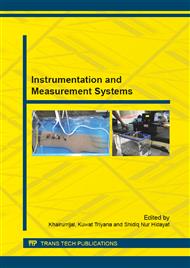p.3
p.9
p.13
p.17
p.21
p.25
p.29
p.33
A Portable and USB-Powered Device for Heart Rate Extraction of Optical Plethysmography Signal
Abstract:
Optical plethysmography technology has been used to design and develop a portable device for heart rate sensor. These device, consisting of near-infrared light-emitting diodes (LEDs) and photodetectors, offer a simple means of extraction the heart rate noninvasively on fingertip’s healthy volunteers. The acquisition signal is carried out based on the detection of the absorbance of near-infrared light in blood vessels due to heart’s pump activity. The microcontroller is used as the main component of electronics module. The communication to personal computer (PC) and power supply of device are provided by USB system. The algorithm of Fast Fourier Transform (FFT) in the software was used to generate the spectra of the signal and determine the HR of the obtained signal. The performance of developed device is tested on 10 fingertips of healthy volunteers, aged 19 to 57 years. A Pulse Oximeter commercial was used as gold standard instrument for comparison of results obtained by the designed device. In this paper the correlation analysis was applied to validate the results of both devices. The analysis show that the HR measured is positively correlated. These results show that the correlation between the HR measured by both the designed PPG device and Pulse Oximeter commercial are almost perfectly linear. Thus, the pulse signals gathered by the designed device are accurately believed to be representative of the heart activity of healthy volunteers. The validation method supports that designed device can potentially be developed as a simple, low power, and portable device for the importance of biomedical research (mainly for processing biomedical signal) and clinical practices.
Info:
Periodical:
Pages:
13-16
Citation:
Online since:
July 2015
Authors:
Keywords:
Price:
Сopyright:
© 2015 Trans Tech Publications Ltd. All Rights Reserved
Share:
Citation:


